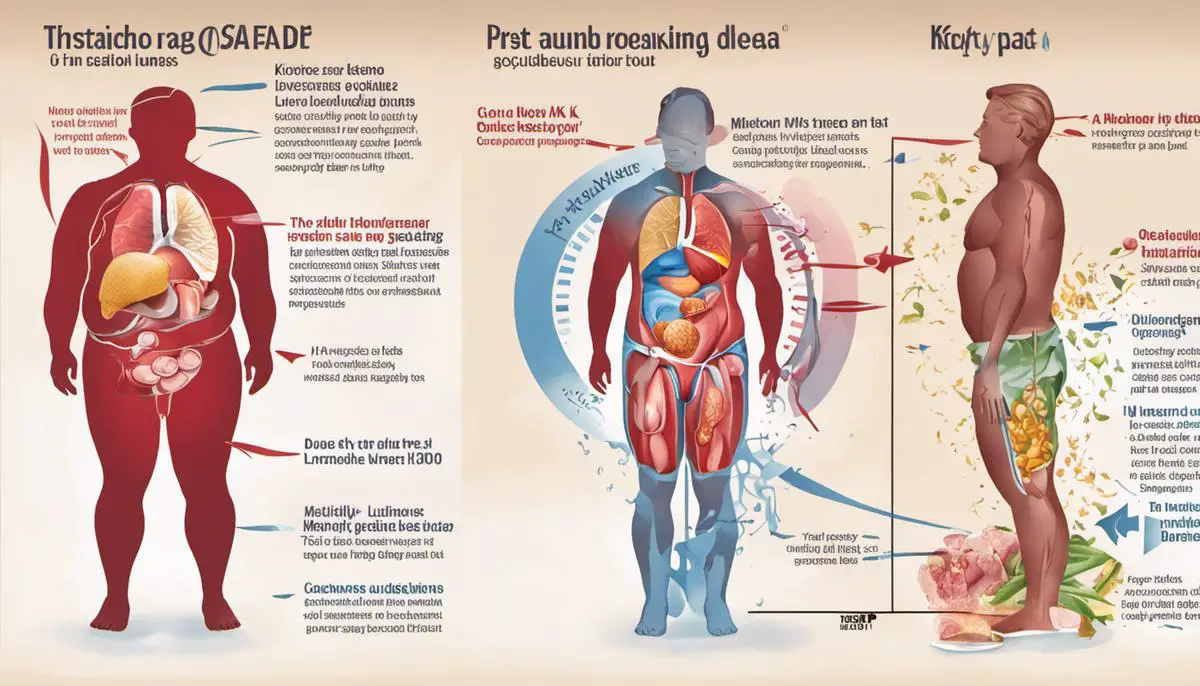Living with diabetes and managing its potential complications requires a substantial understanding of the numerous health dynamics, one of which is Diabetic Ketoacidosis (DKA). This intricate health condition is characterized by an abnormal accumulation of toxic blood acids known as ketones. As general implications, DKA can be a severe, potentially life-threatening complication and its relation to diabetes makes it critical to grasp its concept adequately. In this context, this write-up aspires to transform complex medical terminologies into easily digestible information about DKA, shedding light on its causes, probable risk factors, and the overall impact on your body. It aims to give you an anticipatory guide to recognize the early warning signs of this disorder and equip you with a sound knowledge to act promptly during a medical emergency.
Understanding DKA
Understanding DKA: Foundation and Explanation
Diabetic Ketoacidosis, known as DKA, is a severe and potentially life-threatening condition that primarily occurs in people with type 1 diabetes, but can also happen in those with type 2 diabetes. It’s essentially a state of extreme hyperglycemia, or high blood sugar levels, combined with a severe lack of insulin. In normal conditions, our body uses glucose (sugar) for energy. However, the lack of insulin in DKA forces the body to use fat instead. As the body breaks down fat, it produces ketones, a type of acid, which can accumulate in the bloodstream, leading to ketoacidosis if not treated promptly.
DKA’s Impact on the Body
A high concentration of ketones in the blood can lead to dangerous acid-base imbalance in the body. The body naturally tries to counteract this by increasing the breathing rate to exhale some of this acid. As a result, one of the distinguishing symptoms of DKA is a deep and rapid breathing pattern known as Kussmaul’s respiration. The body’s shift to burning fat for energy instead of glucose can also result in a quick and significant weight loss. Moreover, blood flow changes during DKA can potentially damage heart, liver, and brain cells.
Relation to Diabetes
All people with diabetes—both type 1 and type 2—are at risk for DKA, but the condition is most common in those with type 1. DKA may be the first symptom of undiagnosed diabetes. Otherwise, it most often develops when insulin is not taken as prescribed, or during illness or infection. Additionally, individuals with diabetes who experience a major physical stressor, like surgery, heart attack, or stroke, may develop DKA due to the surge of stress hormones that work against insulin’s actions.
Determining Potential Risk Factors
It is crucial to understand the potential risk factors that can trigger DKA. Foremost among these dangers is ignoring or skipping required insulin doses, as these actions can drastically alter your body’s insulin equilibrium. Being afflicted by disease or infection can lead to an increased production of anti-insulin hormones in your body. Additionally, certain medications like corticosteroids and some diuretics can amplify the risk of DKA. Ignorance or lack of proper diabetes management education can also enhance the chances of developing DKA. Emotional stress, which can upset your body’s hormonal balance and interrupt insulin functionality, can also be a contributing factor. In particular, individuals with a history of substance misuse may find themselves at a heightened risk as such substances can impede the body’s ability to process insulin efficiently.

Recognizing Early DKA Symptoms
Identifying Early DKA Symptoms
DKA, or Diabetic ketoacidosis, is a severe consequence of inadequate insulin in the body; a common issue for individuals battling diabetes. When the body lacks sufficient insulin, it’s forced to use fat as an alternative energy source. This process results in the production of ketones; acids that, if left unchecked, cause a dangerous buildup in your bloodstream, leading to DKA. Thus, identifying the early signs of DKA can be a lifesaving measure.
Excessive Thirst
The first sign of DKA is usually excessive thirst, even after drinking plenty of fluids. This excessive thirst, medically known as polydipsia, is the body’s response to increased blood sugar levels. The kidneys have to work harder to filter and absorb excessive sugar. If they can’t keep up, the excess sugar gets excreted in the urine, dragging along fluids from the tissues, causing frequent urination (polyuria), leading to dehydration and subsequently, an increased thirst.
High Blood Sugar Levels
High blood sugar levels, or hyperglycemia, are another common early symptom of DKA. When the body doesn’t have enough insulin to transport sugar from the blood into your cells, the cells can’t use it for energy. As a result, a high level of sugar builds up in the bloodstream. Common signs of high blood sugar include frequent urination, increased thirst, tiredness, and dry mouth. Rapid, deep breathing and a fast heart rate may also be indicators of high blood sugar and progressing DKA.
Ketone Levels
In tandem with testing blood sugar levels, people with diabetes should regularly check for high levels of ketones in the urine, especially when sick or under stress. High ketone levels are a warning sign that your diabetes is out of control or you are getting sick. Ketone testing kits are available for purchase at drugstores, which allow one to test their urine for elevated ketone levels at home. Visible signs of high ketone levels can include frequent urination, extreme thirst, dry or flushed skin, nausea or vomiting, and sweet, fruity-scented breath.
Awareness is Key
Understanding and recognizing the early signs of Diabetic Ketoacidosis (DKA) are essential for individuals with diabetes. The life-threatening consequences of DKA can be averted if warning signs are noticed promptly, and medical help is sought immediately. Regular check-ins with a healthcare provider, consistent monitoring of blood sugar and ketone levels, and maintaining an overall healthy lifestyle can effectively manage the risk factors associated with DKA.

Severe DKA Symptoms
Recognizing Severe DKA Symptoms: Identifying the Critical Stage
Diabetic ketoacidosis (DKA) is a grave complication of diabetes that can result in death if not promptly addressed. Thus, early detection and accurate identification of symptoms are crucial in providing the needed treatment. One primary symptom is quick, profound, and strenuous breathing, also known as Kussmaul respiration. This occurs as the body attempts to eliminate the excess acids (ketones) in the bloodstream, resulting from insulin deficiency.
A peculiar symptom in DKA patients is fruity-scented breath, caused by an elevated level of ketones in the body. Ketones are compounds produced when inadequate insulin in the blood causes the body to break down fats for energy. One such ketone, acetone, emits a fruity scent detectable on the breath of those with DKA.
In addition, the excess blood acids can trigger nausea and vomiting. Continuous vomiting for more than two hours is a strong indication of potential DKA, a symptom which can exacerbate dehydration, thus worsening the condition.
The brain thrives on stability and balance, which is why fluctuations in blood sugar levels, hydration, and electrolyte balance can negatively impact its functionality. With DKA, mental status alterations can span from mild confusion to extreme cases of coma.
Other extreme symptoms that warrant immediate medical attention are severe abdominal pain, dry or flushed skin, excessive thirst, frequent urination, and significant fatigue. These could be signs of advanced DKA.
The critical stage of DKA is a medical emergency demanding immediate attention. Should these symptoms occur, especially in persons with known diabetes, call 911 without hesitation. Quick recognition and treatment of DKA can remarkably enhance chances of recovery and survival. It is of utmost importance for diabetics and those around them to familiarize themselves with these symptoms and act promptly when they manifest.

Managing and Preventing DKA
Comprehending DKA: Significance and Detection
Diabetic Ketoacidosis (DKA) presents as a medical emergency with indications such as elevated blood sugar levels and insulin deficiency. It predominantly affects those with type 1 diabetes, though it can also impact people with type 2 diabetes. Key symptoms encompass nausea, vomiting, deep and quick breathing, mounting thirst and urination, fatigue, confusion, and a unique kind of abdominal pain. Recognizing these symptoms is vital for initiating efficient management strategies to counter DKA at its earliest stages.
Strategies for Managing DKA Symptoms
Effective management of DKA calls for immediate medical attention. Primarily, intravenous fluids are administered to treat dehydration. Insulin therapy is done to reverse the ketosis process and halt the production of ketones. Electrolyte replacement is carried out to restore the balance of electrolytes in the body. Underlying causes of DKA, such as infection or illness, need to be addressed too.Lifestyle and Dietary Modifications
Lifestyle and dietary modifications are key in both managing and preventing DKA. It is recommended that people with diabetes engage in regular physical activity under the guidance of a healthcare provider. This helps to keep blood glucose levels within normal range and promote overall health.A healthy diet is also paramount. High sugar and high carbohydrate foods can cause blood sugar levels to rise rapidly. Conversely, a diet rich in lean proteins, fresh fruits, vegetables, and whole grains can help maintain consistent blood sugar levels. Limiting alcohol intake and quitting smoking are highly beneficial too.
Prevention Techniques: Routine Glucose Monitoring and Immediate Action
Routine monitoring of blood glucose levels is imperative for any individual with diabetes. This assists in recognizing any abnormal glucose trends or patterns. The information from monitoring can be used to adjust medication, diet, and physical activity.Additionally, people with diabetes should learn how to handle elevated blood glucose levels correctly. Indeed, when levels are abnormally high, taking an extra dose of insulin or another medication, as advised by a healthcare provider, could potentially prevent a DKA episode.
People with diabetes should also have a sick day management plan in place. Illness increases blood glucose levels and your risk for DKA, hence the importance of adjusting your medication and testing your blood glucose and ketone levels more frequently during illness.
Moreover, caregivers and healthcare providers play a pivotal role in educating individuals with diabetes about DKA and its management. This can significantly improve disease outcomes and reduce the frequency of DKA episodes.

Managing Diabetic Ketoacidosis effectively largely depends on enriching yourself with the right knowledge and maintaining a proactive approach towards your health. Recognizing the symptoms can help in early detection and prompt medical intervention, ultimately preventing further health deterioration. Furthermore, adopting certain lifestyle and dietary modifications can go a long way towards DKA mitigation. Regular glucose monitoring and timely reacting when levels are abnormal can also play a significant role in its prevention. Armed with these pieces of information, you or your loved one living with diabetes can navigate the health landscape better, thus promoting a healthier, safer life.
